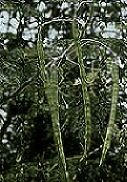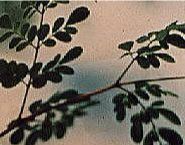Moringa oleifera or M. pterygosperma
Horeradish or Drumstick tree, Marango, Benzolive, Malungay
Tropical


Introduction
Moringa is a small tropical tree that grows to about 25 feet (8 meters). It has tuberous roots and fern-like edible foliage. The pungent horseradish essence is in all parts of the plant. It is native to northern India and was mentioned as a medicinal plant in ancient Sanskrit texts. It has spread gradually throughout much of the tropics through intentional cultivation.
Moringa is fast growing and is often used as a boundary plant or as part of living fence system. The wood is very punky and of little use as lumber or fuel but can be used for making paper. Moringa has a great variety of unusual chemical compounds that are now being investigated for potential medicinal and industrial uses. Moringa leaves are extremely nutritious and this plant has tremendous potential for greater use in the human diet.
Pros
- Possibly the most nutritious of all leaf crops, moringa leaves are 7% protein and have extremely high levels of folates, vitamin C, carotenes, calcium, iron, and niacin. Moringa is truly a multi-purpose crop with edible leaves, flowers and seedpods. Its roots are used as a flavoring and in poultices; and edible oil (ben oil) can be extracted from its seeds.
- Crushed moringa seeds can be used to settle silt and other contaminants from water before final filtration, replacing alum (which is currently used for this purpose) and extending the useful life of water filters. This could be of major importance in areas with high rates of water borne gastrointestinal diseases and without central water purification systems.
- Very drought resistant year round supplier of edible leaves
- Leaves are very easy to harvest by stripping off between thumb and forefinger.
- There is no fibrous petiole or leaf stalk that needs to be removed as with many leaf crops
- Leaves have more than 3 times the dry matter of spinach and thus are very easy to dry.
- Very attractive yard tree when allowed to grow to its full size
- See nutritional analysis of Moringa, the miracle tree.
Cons
- Very susceptible to termite damage.
- Raw leaves may block iodine absorption. This is due to compounds very similar to the goitregens in kale.
- Not tolerant of frost or high altitudes
- Sensitive to waterlogging
Notes
- African moringa (Moringa stenopetala) has larger and more palatable leaves and is often considered generally more desirable.
- Heavy pruning encourages lateral shoots and increased leaf production. It also keeps the leaves at an easy to harvest height.
- Sometimes used to provide partial shade for crops like sorghum in very hot, dry areas
- There is interest in the antibacterial and perhaps anticarcinogenic properties of isothiocyanates and related compounds in moringa.
- Tolerates soil pH from 4.5 – 8.0
- In parts of Africa there are folk beliefs that moringa trees planted on graves keep away hyenas and its branches guard against witchcraft.
- Can be grown as an annual or greenhouse plant in temperate zones
Seeds
ECHO; moringa can be propagated locally with 1-2 meter long cuttings as well as seeds.
Related Plants with Edible Leaves
Moringa ovalifolia (phantom tree); M. stenopetala (cabbage tree); M. peregrina